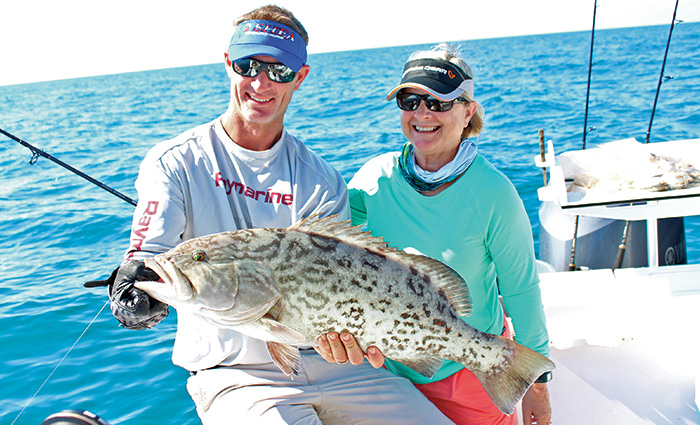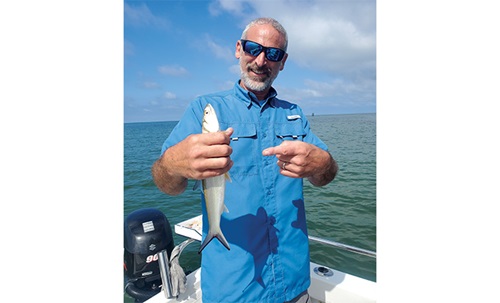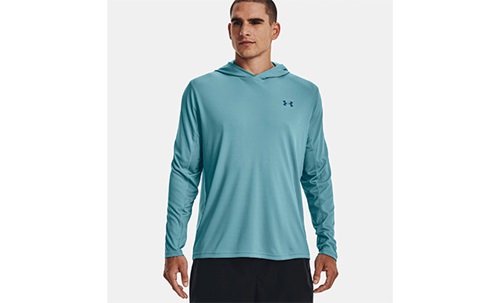Advertisement
Are you reeling from harmful ultraviolet rays? UV-protective clothing adds an extra layer of protection for boaters

UV-protective clothing is a must for boaters. Photo: Lenny Rudow
That big ball of fire in the sky might bring life to planet Earth, but it also bakes, burns, and barbecues us. And while sun protection is important for everyone, boaters in particular are subject to major-league ultraviolet bombardment. The surface of the waters we float upon reflect the sun’s rays and can boost your skin’s exposure by about 10%, shiny white fiberglass gelcoat shines back even more sunlight, and prime boating hours and peak UV exposure (10 a.m. to 4 p.m.) often coincide. So frying while fishing and cooking while cruising are common problems.
Of course, if you’re a boater, you almost certainly already know all about the risks of serious sunburn. You’re aware of the Environmental Protection Agency’s recommendation to use extra caution regarding sunburn when on the water. You know that NOAA considers it so important that its Climate Prediction Center produces a UV index exposure forecast. You’ve heard about the National Institutes of Health’s studies showing that skin cancer is the most common form of cancer in America, that UV exposure is responsible for 86% of melanoma cases, and that protective clothing and sunscreen are the two modern solutions to these problems.
If you spend your time on boats, you’re no stranger to this issue. But, do you know how to dress for sun-protected success?
UVA to UVB
Though shorter-wavelength UVB rays are most harmful to your skin and are the main cause of those red burns, longer wavelength UVA rays also do a number on the epidermis and are specifically associated with premature aging. Both, according to the Skin Cancer Foundation, are carcinogenic.
Sunscreen goes a long way toward protecting your exposed skin from UVB rays, but not all lotions protect against UVA (look for “broad spectrum” printed on the label to choose a sunscreen that protects against both). Plus, coverage isn’t always complete, and it can wash off in the water or via sweat. On top of that, you don’t generally apply sunscreen on skin that is clothed, and while all clothing will shade you, it won’t necessarily stop those UV rays from punching through.
Wearing clothes that are specifically designed to be sun-protective when you’re out on the water is just plain smart. Choosing the right type can be a bit confusing, however. The first critical point is to understand that while sunscreen is rated by SPF (sun protection factor), clothing is generally rated by UPF (ultraviolet protection factor). Those scales measure different things.
Top UPF picks
You shouldn’t have any problem finding high-quality UPF-rated sun-protective clothing that fits your body and taste because there are plenty of companies producing a wide range of options these days. We can’t vouch for them all, but the whole point of using UPF ratings (regulated by the Federal Trade Commission and third-party tested) is to ensure that consumers know exactly what they’re getting. That said, we’ve tested plenty of UPF-rated clothes through the years, and here are some favorites. — L.R.

Photo: Aftco
Aftco Rangle SS Vented Fishing Shirt
UPF RATING: 50
MATERIAL: 98% polyester, 2% elastane
SIZES: Men’s S to 5X (similar long sleeve and
sleeveless styles available in ladies’ S to XL)
These button-down collared shirts are nice because they’re not only comfortable and protective but are also as appropriate for trips to the dockside restaurant as they are for fishing. Vents in the back keep things cool, and the chest pockets are large enough to slide your cellphone into. | aftco.com

Photo: Lenny Rudow
Habit Forage River SS River Guide Fishing Shirt
UPF rating: 40+
Material: 87% polyester,
13% spandex
Sizes: Men’s S to 4XL
The standout feature of the Habit is its comfort. With mesh vents through the back as well as under the arms, plus a bit more range of motion thanks to some stretchy spandex, we like the way this one feels. | habitoutdoors.com

Photo: Lenny Rudow
Columbia Woman’s PFG Tidal Tee II
UPF rating: 50
Material: Polyester interlock
Sizes: Ladies’ XS to XXL; plus 1X to 3X
The Tidal Tee II is silky and lightweight yet still attains the maximum UPF rating and is moisture-wicking to maintain coolness. We also found that it’s amazingly quick-drying. After being inadvertently doused with the washdown hose, our tester reported drying off in just a few minutes. | columbia.com

Photo: Under Armour
Under Armour Iso-Chill Shorebreak Fill Hoodie
UPF Rating: 50+
Material: Polyester
Sizes: Men’s S to 3XL
The Iso-Chill’s lightweight wicking fabric keeps you cool and dries in a blink. Where it scores extra points is in the protection factor because long sleeves and a hood allow you to cover up just about everything north of the belt line. | underarmour.com
SPF measures how much longer a sunscreen will allow you to remain in the sun before burning. SPF 30, for example, should allow you to be in sunshine 30 times longer than if you were unprotected, without becoming a lobster. UPF on the other hand, measures the specific amount of UV light penetration through the fabric.
The UPF range spans from 15 through 50, and clothing under 15 is generally not rated as sun-protective. As a point of reference, a regular cotton T-shirt would be around UPF 5. UPF ratings would seem straightforward, but they can actually be a bit confusing to anyone who’s accustomed to using SPF’s time-to-burn as a point of reference. So what exactly do those UPF numbers mean? They measure the fraction of UV light allowed to pass through the fabric. UPF 15 allows 1/15 of the rays to pass through, UPF 30 allows 1/30 through, and so on.
Keep in mind that this leads to a sort of diminishing return as UPF ratings go from high to higher. UPF 50 sounds a whole lot more protective than UPF 30, but you’re actually looking at the difference between 3.333% (1/30) and 2% (1/50) of the sun’s rays getting through – obviously a very different scale than the SPF difference between 30 times longer and 50 times longer.
Just what gives a fabric its UPF-ness? The weave is critical, as is the material. Polyesters tightly woven with nanofibers are a common option for sun-protective clothing. Chemical UV absorbers may also be infused into the fabric, and these are generally the same ones we’re familiar with from sunscreen: titanium dioxide or zinc oxide. The dyes used to color the fabric can also help prevent UV radiation from filtering through, with darker dyes tending to add more protection than lighter ones.
Fun in the sun
Along with UPF there are several additional factors to consider when choosing the best sun-protective clothing for your needs. Breathability is a huge one, because overheating and sweating are big problems if tightly woven fabrics aren’t vented properly. In some cases, you may also want to consider additional integrated protective gear, like hoods or flip-up collars. We boaters get wet on a regular basis, so choosing a quick-drying fabric is a good move – particularly because some UPF-rated clothing loses effectiveness when wet.
The push for clothing that’s both sun-protective and comfortable has been consumer-driven and, according to Aftco’s Matt Florentino, has resulted in many hours of in-house and on-the-water testing for the company’s angler-centric clothing.
“A technical shirt with 40 to 50+ UPF rating is extremely important to alleviate the harmful effects of the sun’s rays,” he says. “But anglers also need the benefits of staying cool, dry, and comfortable through long days on the water. In essence you’ll be able to fish longer, feel less fatigue, and prevent sunburn so you’re ready for tomorrow’s adventure. You can keep your focus on the next cast, not a nagging sunburn.”
Getting properly sized clothing is important as well. Shirts or pants that are too big won’t have a negative effect on their UPF protection, but if you try to wear clothing that’s tightly fitted, it may. When the fabric gets stretched and its fibers pull away from each other, it can significantly reduce the clothing’s effective sun-blocking power.
You say you’d rather not start sizzling while sailing? You want complete sun protection whether you’re kicked back in the cockpit or basking on the bow? Yes, you still need that sunscreen for exposed body parts. But sun-protective, UPF-rated clothing gives you a reliable barrier and can keep you more comfortable than cotton at the very same time.
